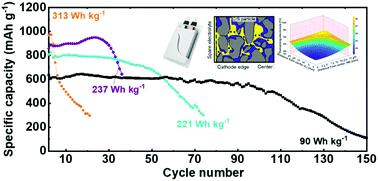当前位置:
X-MOL 学术
›
Energy Environ. Sci.
›
论文详情
Our official English website, www.x-mol.net, welcomes your feedback! (Note: you will need to create a separate account there.)
Reaction heterogeneity in practical high-energy lithium–sulfur pouch cells
Energy & Environmental Science ( IF 32.5 ) Pub Date : 2020-09-04 , DOI: 10.1039/d0ee02088e Lili Shi 1, 2, 3, 4 , Seong-Min Bak 4, 5, 6, 7 , Zulipiya Shadike 4, 5, 6, 7 , Chengqi Wang 4, 8, 9, 10 , Chaojiang Niu 1, 2, 3, 4 , Paul Northrup 4, 11, 12, 13 , Hongkyung Lee 1, 2, 3, 4 , Arthur Y. Baranovskiy 1, 2, 3, 4 , Cassidy S. Anderson 1, 2, 3, 4 , Jian Qin 1, 2, 3, 4 , Shuo Feng 1, 2, 3, 4 , Xiaodi Ren 1, 2, 3, 4 , Dianying Liu 1, 2, 3, 4 , Xiao-Qing Yang 4, 5, 6, 7 , Fei Gao 4, 8, 9, 10, 14 , Dongping Lu 1, 2, 3, 4 , Jie Xiao 1, 2, 3, 4 , Jun Liu 1, 2, 3, 4, 15
Energy & Environmental Science ( IF 32.5 ) Pub Date : 2020-09-04 , DOI: 10.1039/d0ee02088e Lili Shi 1, 2, 3, 4 , Seong-Min Bak 4, 5, 6, 7 , Zulipiya Shadike 4, 5, 6, 7 , Chengqi Wang 4, 8, 9, 10 , Chaojiang Niu 1, 2, 3, 4 , Paul Northrup 4, 11, 12, 13 , Hongkyung Lee 1, 2, 3, 4 , Arthur Y. Baranovskiy 1, 2, 3, 4 , Cassidy S. Anderson 1, 2, 3, 4 , Jian Qin 1, 2, 3, 4 , Shuo Feng 1, 2, 3, 4 , Xiaodi Ren 1, 2, 3, 4 , Dianying Liu 1, 2, 3, 4 , Xiao-Qing Yang 4, 5, 6, 7 , Fei Gao 4, 8, 9, 10, 14 , Dongping Lu 1, 2, 3, 4 , Jie Xiao 1, 2, 3, 4 , Jun Liu 1, 2, 3, 4, 15
Affiliation

|
The lithium–sulfur (Li–S) battery is a promising next-generation energy storage technology because of its high theoretical energy and low cost. Extensive research efforts have been made on new materials and advanced characterization techniques for mechanistic studies. However, it is uncertain how discoveries made on the material level apply to realistic batteries due to limited analysis and characterization of real high-energy cells, such as pouch cells. Evaluation of pouch cells (>1 A h) (instead of coin cells) that are scalable to practical cells provides a critical understanding of current limitations which enables the proposal of strategies and solutions for further performance improvement. Herein, we design and fabricate pouch cells over 300 W h kg−1, compare the cell parameters required for high-energy pouch cells, and investigate the reaction processes and their correlation to cell cycling behavior and failure mechanisms. Spatially resolved characterization techniques and fluid-flow simulation reveal the impacts of the liquid electrolyte diffusion within the pouch cells. We found that catastrophic failure of high-energy Li–S pouch cells results from uneven sulfur/polysulfide reactions and electrolyte depletion for the first tens of cycles, rather than sulfur dissolution as commonly reported in the literature. The uneven reaction stems from limited electrolyte diffusion through the porous channels into the central part of thick cathodes during cycling, which is amplified both across the sulfur electrodes and within the same electrode plane. A combination of strategies is suggested to increase sulfur utilization, improve nanoarchitectures for electrolyte diffusion and reduce consumption of the electrolytes and additives.
中文翻译:

实际高能锂硫袋式电池中的反应异质性
锂硫(Li–S)电池由于其理论能量高且成本低而成为一种有前途的下一代储能技术。对于机理研究的新材料和先进的表征技术已经进行了广泛的研究。但是,由于对诸如袋式电池之类的真实高能电池的分析和表征有限,因此无法确定在材料层面上的发现如何应用于实际电池。可扩展到实际电池的袋式电池(> 1 A h)(而不是纽扣电池)的评估提供了对当前局限性的关键理解,这使得能够提出进一步提高性能的策略和解决方案。本文中,我们设计和制造了超过300 W h kg -1的袋式电池,比较高能袋式细胞所需的细胞参数,并研究反应过程及其与细胞周期行为和失效机制的相关性。空间分辨的表征技术和流体流动模拟揭示了袋装电池内液体电解质扩散的影响。我们发现,高能Li-S袋式电池的灾难性故障是由最初几十个循环中不均匀的硫/多硫化物反应和电解质耗竭引起的,而不是文献中通常报道的硫溶解。不均匀反应源于循环过程中有限的电解质通过多孔通道扩散进入厚阴极的中央部分,这种现象在硫电极上和同一电极平面内都被放大。
更新日期:2020-10-14
中文翻译:

实际高能锂硫袋式电池中的反应异质性
锂硫(Li–S)电池由于其理论能量高且成本低而成为一种有前途的下一代储能技术。对于机理研究的新材料和先进的表征技术已经进行了广泛的研究。但是,由于对诸如袋式电池之类的真实高能电池的分析和表征有限,因此无法确定在材料层面上的发现如何应用于实际电池。可扩展到实际电池的袋式电池(> 1 A h)(而不是纽扣电池)的评估提供了对当前局限性的关键理解,这使得能够提出进一步提高性能的策略和解决方案。本文中,我们设计和制造了超过300 W h kg -1的袋式电池,比较高能袋式细胞所需的细胞参数,并研究反应过程及其与细胞周期行为和失效机制的相关性。空间分辨的表征技术和流体流动模拟揭示了袋装电池内液体电解质扩散的影响。我们发现,高能Li-S袋式电池的灾难性故障是由最初几十个循环中不均匀的硫/多硫化物反应和电解质耗竭引起的,而不是文献中通常报道的硫溶解。不均匀反应源于循环过程中有限的电解质通过多孔通道扩散进入厚阴极的中央部分,这种现象在硫电极上和同一电极平面内都被放大。



























 京公网安备 11010802027423号
京公网安备 11010802027423号